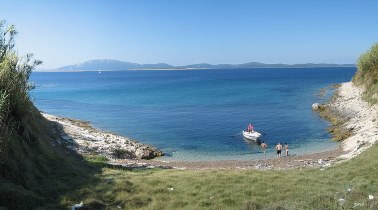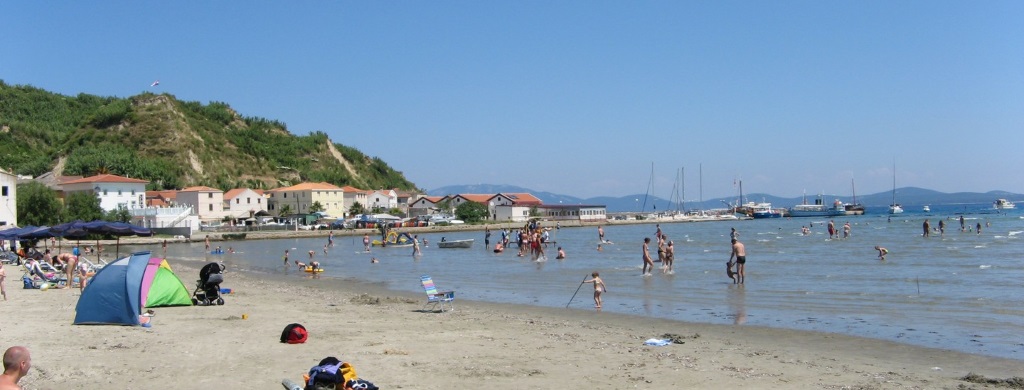Susak’s Beaches
When talking about beaches or coves, Susak has two sides: a northen side which is facing Mali Lošinj, and the southern side which is exposed to open see (it’s facing Italy). Apart from their orientation, both sides differ in the shape of the coastline, depth of the water and accessibility.
Instead to sticking to one beach for the duration of your stay at the island, it’s smarter to visit as many beaches as possible and select the one which you like the most!
Susak isn’t a big island, meaning this should not be too difficult. In fact is’t so small that you can hike around it in a few hours (see hiking around Susak). If hiking is not you style, try renting a boat or ask someone to take you for a round trip.
Northern beaches
Since the village is located on the north west side of the island, it’s the side people are most familiar with. The water here is mostly shallow with depth up to 10 meters. Beaches are easily accessible and can be reached by walking along the coast.
The two sandy shallow bays the island is famous for are both are located on this side of the island. Although the bottom is covered with sand in most of the beaches, these are the only two truly sand-covered beaches on the whole island. Most other coves on the island are covered with pebbles or feature flat rock shelves.
Although being protected from the open sea, the north west side of the island is exposed to bura storms - a strong cold wind blowing from inland. The wind forms as cold air masses descend down the mountain of Velebit. It’s very strong and dangerous near the coast, however is looses most of it’s strength as it reaches Susak.
Waves created by bura get amplified in the shallow waters of Spiăza and Bok bays. Although swimming through these big waves and playing with them might not be such a great idea in the open see, it’s great fun when you do it in the shallow waters of these two bays!

Baldarka Bay
nice little bay covered with pebbles and dry posidonia see grass

Bok Bay
shallow waters, soft sand, a lot of people

Punta Valica Bay
small and an often overlooked beach, with perfect view of the sunset

Spiăza Bay
the most crowded bay with benefit of being the most accessible and safe for children
On some beaches dogs are not welcome
Dog owners should are warned that dogs are not welcome at beaches in the Bok i Spiaza bay. Other people will not only give you an evil eye but will probably openly complain and may become confrontational.
If bringing a dog to the beach is a must then go to some of less popular beaches, such as the ones west of the port. You should be fine in Baldarka bay since it’s never crowded!
Southern beaches
The southern side of the island is a lot less hospitable. Despite that it has got it’s charms.
The coast is much more dramatic and ranges from vertical cliffs dropping directly to depth up to 20 meters, through small lovely coves in which you can have absolute peace and privacy, to larger bays in which yachts find shelter during the bura storms.
Due to its south-west orientation this side is sheltered from the bura wind, but is directly hit by jugo wind. Unlike bura, during which swimming in the bays of Spiăza and Bok is quite harmless, waves created by jugo wind combined with sharp rocky shore can be a deadly trap. What that looks like can be seen in the video Jugo in Obis bay
Only a few bays and coves can be reached by paths running from the upper village. Others can also be reached by foot if you walking along the coast. However since the terrain is quite rough, it will take you a bit of time and a pair of good shoes (sneakers will do) to get there. The easiest way is to go by boat.

Nasuzanski Bay
intensive blue see enriched by the glittering white sandy seabed

Obis Bay
cliffs, rocks, deep water - ideal for diving

Porat Bay
shallow peaceful cove usually visited by boat only

Potarnak Bay
most distant beach, accessible only by boat

Tijesni Bay
bay of shallow warm ponds

Zali Bok Bay
small and narrow cove which you can make your own
Water quality
Water quality is great on all the beaches except around the sewage pumping plant and release pipe located a few hundred meters west of Susak’s port.
Due to sewage release pipe’s insufficient length the sewage is released to close to the coast, leading to water contamination.
The water around the swage treatment plant is visibly murky, indicating that presence of contamination. Carried by sea currents and the wind the contaminated water is spread and can even reach Susak’s port.
Swimming at the mentioned location presents a health hazard and is not recommended.
Polution
Tankers on their way to port of Rijeka pass a few miles outside the coast of Susak. Before being refilled at the oil terminal they have to empty their ballast tanks. Older tankers keep the ballast waters in the same tanks in which they also carry oil. When the ballast water is released it still contains a small amount of oil, which is then carried by the currents and waves until it reaches coast. Because of this parts of beaches are covered in black tar. When the sun melts this tar, it transforms into a sticky dense mass. Be careful not to step into it. If you do, you can clean it with gasoline.
